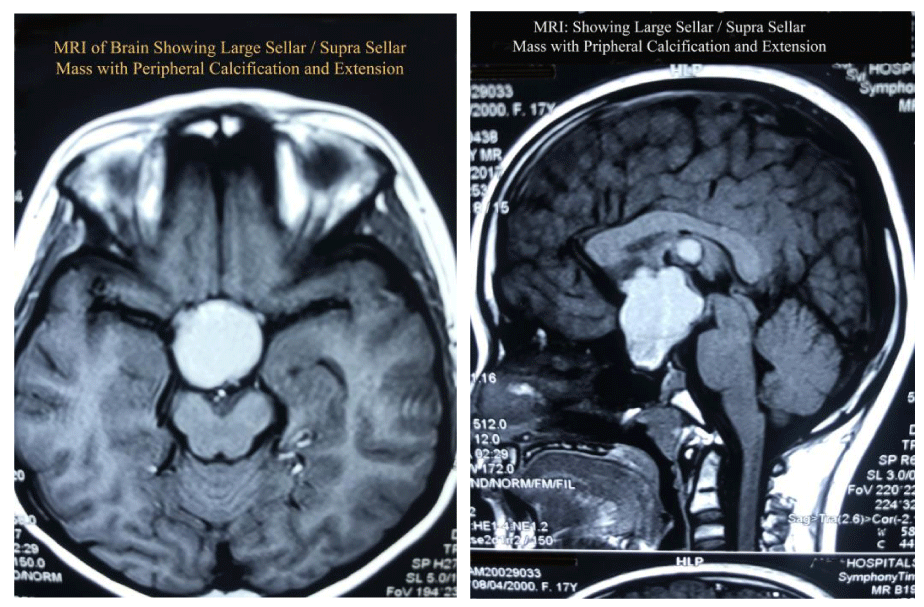Global Journal of Medical and Clinical Case Reports
Primary Amenorrhea due to Craniopharyngyoma
Vanremmawii*
Cite this as
Vanremmawii (2018) Primary Amenorrhea due to Craniopharyngyoma. Glob J Medical Clin Case Rep 5(2): 014-015. DOI: 10.17352/2455-5282.000061Introduction
Amenorrhoea is a very common complaint in obstetrics and gynecology outdoor patient department, but primary amenorrhea is not a common complaint. Primary amenorrhea is defined as absence of menstruation by age 14 with absence of growth or development of secondary sexual characteristic or as absence of menstruation by 16 years regardless of presence of normal growth and development of secondary sexual characteristics [1].
We present a rare case of craniopharingyoma presenting with hypopituitary hypogonadism.
Case Report
Ms. Abc 15 years old, an only child of non-consanguineous parents presented to OPD on 26th May 2015 with a complaint of primary amenorrhea and stunted growth. On examination she had an infantile look; her blood pressure was 120/70, weight 26kg, height 121.9cm with a BMI of 17.5. On examination for secondary sexual characteristics, breast development was Tanner stage 1, absence of pubic and axillary hair, and external genitalia was normal with patent vagina. She had been given combined oral contraceptive pill and she had withdrawal bleeding as long as she was on combined oral contraceptive pill (Figure 1).
On investigation complete hemogram, LFT, KFT, serum electrolytes were normal, ultrasound whole abdomen show rudimentary uterus, TSH-4.40, serum Estradiol <10pg/ml, FSH-0.65mIU/ml, LH-0.10mIU/ml. She was referred to an endocrinologist, but for financial constraints she did not meet the endocrinologist. She came to the OPD again in September 2016 and CECT study head was done which revealed well defined heterogeneously enhancing lesion with peripheral calcification in pituitary gland. She was again advised to go to Neurosurgeon who she met 7 months later.
On examination, her weight as 26kg, height 121.9cm, blood pressure normal. Blood investigation show normal KFT, normal serum electrolytes, normal CBC, normal LFT, TSH-5.940 microIU/ml, Free T4-0.547 ng/dl, FSH<0.01 mIU/ml, LH-<0.010 mIU/ml, Prolactin-8.25 ng/ml, serum cortisol (0.7 micogram/dl, ACTH (29.0 pg/ml) growth hormone (.018 ng/ml), IGF (164 ng/ml), and karyotyping is 46XX. MRI of brain show large suprasellar mass with peripheral calcification and extension suggestive of craniopharingyoma. She was operated on 2/5 17 but unfortunately died on 8th may 2017 due to septic shock (Figure 2).
Discussion
The most common reason for delayed puberty is constitutional delay; another common reason is ovarian failure which is also called hypergonadotropic hypogonadism. Hypogonadotropic hypogonadism occur when FSH and LH are low, most common cause being chronic illness, starvation, excessive exercise, anorexia nervosa, depression and stress etc. Tumors in the CNS can compress the portal vessels and impede the flow of GnRH from the hypothalamus to the pituitary gland. Pituitary adenoma, caniopharyngioma and meningioma tumors are example of slow growing non-metastatic tumors that are uncommon cause of Hypogonadotropic hypogonadism. Evaluation should begin if no pubertal development occurs by 13 and no menarche by 15 years or if menarche has not occurred within 5 years of thelarche. The differential diagnoses of primary amenorrhea include secondary amenorrhea, pregnancy. hyperprolactinaemia, thyroid dysfunction, primary ovarian insufficiency related to chromosomal abnormalities and polycystic disease of ovary. The differential diagnoses also include congenital absence of vagina, vaginal septum, imperforate hymen and 46XY disorders. So, a thorough history and physical examination should be the first step in primary amenorrhea work up. Leonard P et al. [2], reported 3 patients of craniopharyngyoma who had galactorrhea, oligomenorrhea and amenorrhea with abnormal sellar tomograms [2]. Mathew R Garret said that craniopharyngyoma are generally slow growing tumor and often a delay of 1-2 years between onset and symptoms. And the incidence is 0.13-2/100,000 per year with peak incidence in 5-14 yrs [3].
- Speroff L, Glass RH, Kase NG (1999) Clinical gynecologic endocrinology and infertility, 6th edition. Lippincott Williams and Wilkins 422.
- Leonard PK, Mark EM, Kalmon DP, Bruce JB, Robert JP, et al. (1980) Galactorrhea, Oligo/Amenorrhea, and Hyperprolactinemia in Patients with Craniopharyngiomas. The journal of clinical endocrinology and metabolism 51: 798-800. Link: https://tinyurl.com/yc97eo89
- Garnett MR, Puget S, Grill J, Sainte-Rose C (2007) Craniopharyngioma. Orphanet Journal of Rare Diseases 2: 18. Link: https://tinyurl.com/ybn3l83e

Article Alerts
Subscribe to our articles alerts and stay tuned.
 This work is licensed under a Creative Commons Attribution 4.0 International License.
This work is licensed under a Creative Commons Attribution 4.0 International License.


 Save to Mendeley
Save to Mendeley
